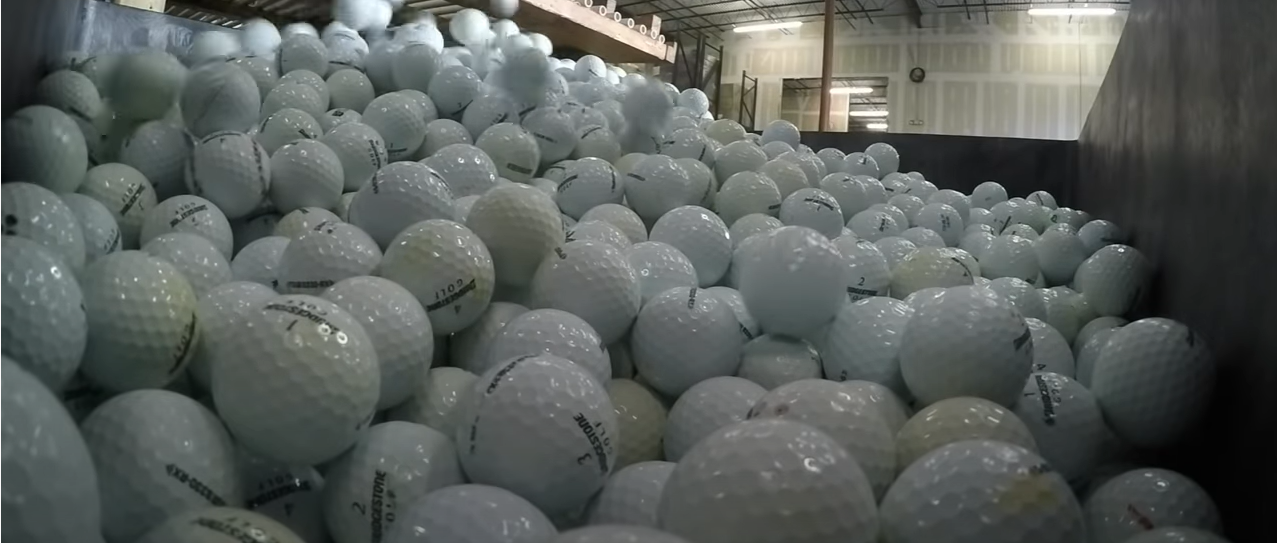
Interesting fact: an estimated 300 million golf balls are lost annually in the United States alone. That’s quite literally millions of dollars tossed into the belly of nature without hope of ever being found or retrieved again.
On top of that, there’s the environmental concern that goes with the waste of cash. What happens to these balls when lost and left behind? Well, to paint that picture, experts have estimated that a single golf ball might take more than 1,000 years to fully decompose. Yikes!
To help mitigate the waste and the environmental damage, many businesses have dwelt into seeking and refurbishing lost, discarded balls. Today, you’re likely to find everything from recycled to refinished golf balls. But will their subpar quality be bad for your game?

We all know what new golf balls are. But what exactly is the difference between recycled vs refurbished golf balls? While both of these types of balls come from used, discarded golf balls, the process by which they're brought to the end users are significantly distinct.
The recycled golf ball is the cheapest you’ll find. After being collected from golf courses and wherever else, these balls are washed and then sorted by brand and type. To guarantee consistent quality across the board, balls will be lumped together depending on their color and cover quality. Balls with less scuffing and damage will cost slightly more than those with more surface abrasions and imperfections.
PROS | CONS |
|---|---|
Much like recycled balls, these balls were previously used and then discarded or lost. But what makes them different is that they’re not simply washed and sorted. On the contrary, a refurbished ball goes through a process of sandblasting where the paint and outer covering are stripped off. The ball is then repainted and rebranded. This makes the balls look brand new, and may offer slightly better performance than recycled balls due to minimized surface damage.
PROS | CONS |
|---|---|
Well, what else is there to say? A new golf ball comes fresh out of a pack and has ultimately never been used. They’re the most expensive of all types of balls, but they also offer marginally improved performance for golfers with elevated stroke sensitivity.
PROS | CONS |
|---|---|

To be perfectly honest, it can be tough to really notice the difference between the performance of a new golf ball versus something refurbished or recycled. Unless you’ve been playing for decades and are highly attuned to the strike feel of your club set, it can be tough to really pick out how these three different ball types are different.
However there are slight variations to their performance. So if you’re a high handicapper who wants to leverage every opportunity for better play, then brand new balls might be the way to go.
When it comes to recycled and refurbished balls, you’d probably want to stick to recycled for as long as they’re in stock. Why? Because they haven’t been buffed out, it’s easier to see the real condition that they’re in. The same can’t be said for a refurbished ball, which can be made to look like it’s in far better shape than it actually is.
But are refinished golf balls bad? Not necessarily. For practice and casual play, they can be more than good enough. Just be on the lookout for manufacturers that might slap on a premium brand or logo on a refurbished dime store ball. It’s also worth knowing that because they’re re-coated, a refurbished ball might chip and crack after just a few rounds.
Are you playing a tournament or just swinging a few on the driving range? Unless you need top notch performance, you can save up on recycled and refurbished balls for practice.
You’d be surprised how good a recycled ball can be. Check your options and really inspect each ball. Those with minimal scuffing and fewer stains indicate that the balls may have been used less and were less exposed to heat and water.
Some brands are expensive simply because of their name. There’s no need to shell out so much for a ball that will end up lost in a lake or forest. Skip the ultra expensive picks and settle for cost-effective balls that don’t skimp out on quality.
With no alterations of the manufacturer’s original specifications, the Reload Recycled Nike Golf Balls have become a crowd favorite. Close to 50% cheaper than brand new balls, these balls have been cleaned and sorted. The balls are in such good condition in fact, that many of those who have purchased them claim that it’s tough to even tell that they were ever used at all.
Refined and refinished to look and feel like brand new balls, the Taylormade TP5 Refurbished Golf Balls cost a mere fraction of the brand new balls. Recoated to perfection, these balls are guaranteed to be without pen marks, bruises, or scuffing, and promise excellent Taylormade-grade performance on the green.
Dubbed some of the best value balls on the market, the Wilson Ultra 500 Distance Golf Balls come in a premium yellow finish to help make sure you lose as little number of balls as possible. Significantly easier on the pocket than many other premium golf ball models, these balls guarantee professional performance without putting so much as a divot in your wallet.
Whether you’re buying brand new vs recycled vs refurbished golf balls, there’s always one thing you need to remember - even used, abused balls will still have some play in them. So the next time you find yourself shelling out for a whole new batch of balls, take the time to retrieve them whenever possible. You’re not only saving yourself an added expense, but you’re also doing your little part to keep your balls out of nature’s business.